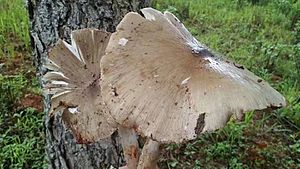Odontotermes obesus facts for kids
Quick facts for kids Odontotermes obesus |
|
|---|---|
| Scientific classification | |
| Genus: |
Odontotermes
|
| Species: |
obesus
|
| Synonyms | |
|
|
Odontotermes obesus is a type of termite. It belongs to the Termitidae family. These termites live in warm, wet parts of southwestern Asia. They are special because they grow their own food! They have a secret garden inside their nest. In this garden, they grow a special fungus. Worker termites collect dead plants and chew them up. This makes a perfect bed for their fungus to grow on.
Contents
Life in a Termite Colony
Termites like Odontotermes obesus have a special way of starting new families. They fly out in large groups during April and May. This happens just before or during the rainy season. After their flight, a male and female termite pair up. They look for a crack in the soil or loose dirt. This is where they will build their new home.
Building the Nest
The first part of their nest is a cone-shaped mound. It has small cone-shaped towers on top. The fungus garden is right in the middle of this cone. It is sometimes called the "comb." The royal chamber, where the king and queen live, is underneath. As the termite family grows, they add more tunnels and rooms. The nest mostly grows taller and taller.
The Termite's Special Fungus
The fungus that these termites grow is called Macrolepiota albuminosa. This fungus only grows with termites. It grows on the waste that the termites produce. It's like a special farm just for them!
What Termites Eat
The termites in the colony eat only the fungus they grow. This fungus grows in their underground garden. Worker termites search for the best materials for their fungus garden. They gather bark, pieces of wood, dead leaves, and dry animal waste.
Termites and Crops
When they collect these materials, they can cause a lot of damage. They harm important crops like wheat, barley, and maize (corn). They also damage pearl millet, sorghum, sugarcane, groundnut, and tea.
How Termites Digest Food
The termites chew up the materials they collect. Then, tiny helpers called bacteria in their gut help them. These bacteria have special tools called enzymes. These enzymes break down tough plant parts like cellulose. This helps the termites digest their food.
The fungus comb is always being recycled. Worker termites eat the oldest parts of the comb. Then, they produce new comb material. The tiny threads of the fungus, called hyphae, grow very quickly through the new comb. Sometimes, the fungus makes small, round parts. These are eaten by the workers. They are also carried to other parts of the fungus comb. This helps the fungus spread.
How New Fungus Gardens Start
Scientists have studied how new fungus gardens begin. In some termite species, the flying termites swallow these round fungus parts. They keep them safe in their gut. Later, they use their waste to start a new fungus comb in their new home.
In other species, like Odontotermes montanus, the fungus parts are not carried. Instead, worker termites bring back tiny fungus seeds. These seeds come from the mushrooms of the fungus. These mushrooms grow above ground on the termite mound.


